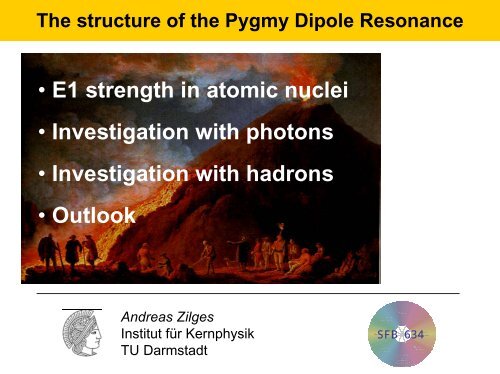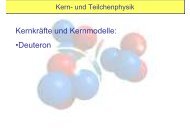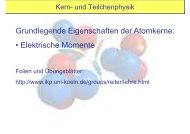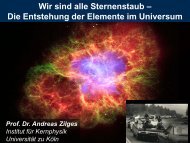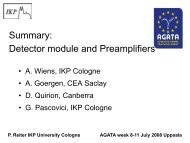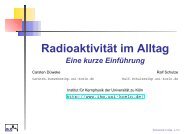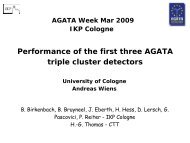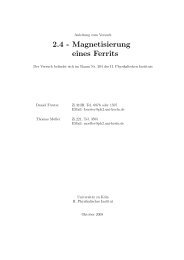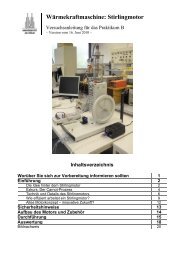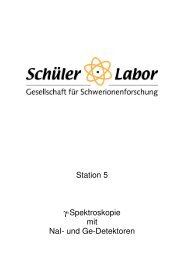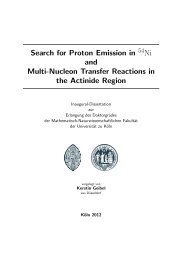The structure of the Pygmy Dipole Resonance
The structure of the Pygmy Dipole Resonance
The structure of the Pygmy Dipole Resonance
Create successful ePaper yourself
Turn your PDF publications into a flip-book with our unique Google optimized e-Paper software.
<strong>The</strong> <strong>structure</strong> <strong>of</strong> <strong>the</strong> <strong>Pygmy</strong> <strong>Dipole</strong> <strong>Resonance</strong><br />
• E1 strength in atomic nuclei<br />
• Investigation with photons<br />
• Investigation with hadrons<br />
• Outlook<br />
Andreas Zilges<br />
Institut für Kernphysik<br />
TU Darmstadt<br />
SFB 634
E1 strength distribution in atomic nuclei<br />
Strength<br />
?<br />
5 10 15<br />
Energy/MeV<br />
• Two Phonon Excitation: E x ~ 3 MeV, B(E1) ~ 10 -2 W.u.<br />
• Giant <strong>Dipole</strong> <strong>Resonance</strong>: E x ~ 18 MeV, B(E1) ~ 10 W.u.<br />
• <strong>Pygmy</strong> <strong>Dipole</strong> <strong>Resonance</strong>
Measuring <strong>the</strong> below and above <strong>the</strong> threshold<br />
Photon scattering (γ,γ‘)<br />
Strength<br />
5 10 15<br />
Energy/MeV<br />
Photodissociation (γ,n), (γ,p), …<br />
Real and virtual photons can be used for excitation!<br />
stable nuclei<br />
stable and radioactive nuclei
<strong>The</strong> <strong>Pygmy</strong> <strong>Dipole</strong> <strong>Resonance</strong><br />
Experiment (below S n )<br />
A. Jung et al., Nucl. Phys. A584 (1995) 103<br />
K. Govaert et al., Phys. Rev. C 57 (1998) 2229<br />
N. Ryezayeva et al., PRL 89 (2002) 272502<br />
A. Zilges et al., Phys. Lett. B 542 (2002) 43<br />
N. Pietralla et. al, PRL 88 (2002) 012502<br />
J. Enders et al., Nucl. Phys. A724 (2003) 243<br />
T. Hartmann et al., PRL 93, (2004) 192501<br />
L. Käubler et al., Phys. Rev. C 70 (2004) 064307<br />
S. Volz et al., Nucl. Phys. A779 (2006) 1<br />
G. Rusev et al., Phys. Rev. C 73 (2006) 044308<br />
U. Kneissl, et. al., Journ. Phys. G 32 (2006) R217<br />
<strong>The</strong>ory<br />
(γ,γ’)<br />
J. Chambers, E. Zaremba, J.P. Adams, B. Castel, Phys. Rev. C 50 (1994) R2671<br />
A.M. Oros, K. Heyde, C. De Coster, B. Decroix, Phys. Rev. C 57 (1998) 990<br />
D. Sarchi, P.F. Bortignon, G. Colò, Phys. Lett. B 601 (2004) 27<br />
S. Goriely, E. Khan, M. Samyn, Nucl. Phys. A739 (2004) 331<br />
N. Tsoneva, H. Lenske, C. Stoyanov, Phys. Lett. B 586 (2004) 213<br />
N. Paar, T. Niksic, D. Vretenar, P. Ring, Phys. Lett. B 606, (2005) 288<br />
J. Terasaki, J. Engel, Phys. Rev. C 74 (2006) 044301<br />
V. Tselyaev, J. Speth, F. Grümmer, S. Krewald, A. Avdeenkov et al.,Phys. Rev. C 75 (2007) 014315<br />
G. Tertychny, V. Tselyaev, S. Kamerdzhiev, J. Speth, E. Litvinova et al., Phys. Lett. B 647 (2007) 104
Photon scattering <strong>of</strong>f 136 Xe<br />
E1 excitations<br />
Energy [keV]<br />
D. Savran, S-DALINAC TU Darmstadt
Systematics <strong>of</strong> <strong>the</strong> <strong>Pygmy</strong> <strong>Dipole</strong> <strong>Resonance</strong><br />
• Concentration<br />
around 5-7 MeV<br />
• Strong fragmentation<br />
• Summed strength:<br />
Scaling with N/Z ?<br />
A. Zilges et al., PLB 542 (2002) 43<br />
S. Volz et al., NPA 779 (2006) 1
Summed E1 strength below S n<br />
(preliminary)<br />
N=82 Z=50<br />
A. Zilges et al., PLB 542 (2002) 43<br />
S. Volz et al., NPA 779 (2006) 1<br />
K. Govaert et al., PRC 57 (1998) 2229<br />
B. Özel et al., NPA 788 (2007) 385
Summed E1 strength below S n : <strong>The</strong>ory vs Exp.<br />
QPM calculation: N. Tsoneva, H. Lenske et al.<br />
(see S. Volz et al., NPA 779 (2006) 1)
Charge Transition Density <strong>of</strong> PDR in 208 Pb<br />
208<br />
Pb<br />
ETFFS: V. Tselyaev et al., Phys. Rev. C 75 (2007) 014315
E1 strength folded with Lorentzian (F. Iachello)<br />
From experiment:<br />
Energy [keV]<br />
Energy [keV]<br />
Electromagnetic probes<br />
alone are not sufficient !
α particles vs. photons (macroscopic)<br />
Multipolarity<br />
Isospin<br />
“Location”<br />
Energy resolution<br />
(@ E X = 8 MeV)<br />
(γ,γ’)<br />
(EM interaction)<br />
E1,M1,(E2)<br />
(ground state decay<br />
width Γ 0<br />
)<br />
isovector<br />
whole nucleus<br />
(kR « 1)<br />
7-10 keV<br />
(α,α’)*<br />
(strong interaction)<br />
E0,E1,E2,E3<br />
(angular distribution)<br />
isoscalar<br />
surface peaked<br />
(strong absorption)<br />
30-100 keV<br />
(straggling)<br />
* 130 MeV und forward angle<br />
⇒ New <strong>structure</strong> information<br />
⇒ Important for spectroscopy <strong>of</strong> PDR
Investigating <strong>the</strong> PDR with α-particles<br />
Big Bite Spectrometer (BBS)<br />
TUD<br />
α‘<br />
α<br />
E α ~130 MeV<br />
Ge-Detektor-Array detector array für<br />
for detection γ-Spektroskopie <strong>of</strong> γ decays<br />
European Supernova Detector<br />
for measurement <strong>of</strong> α-particles,<br />
∆E ~ 100-200 keV<br />
This setup combines isospin selectivity and skin sensitivity <strong>of</strong><br />
α-particles with spin selectivity and energy resolution <strong>of</strong> γ-spectroscopy<br />
D. Savran et al, NIM A 564 (2006) 267
<strong>The</strong> new ISOSPIN setup at KVI<br />
TUD<br />
Total photopeak efficency: ~0.1% at 9 MeV
2D-energy matrix: (α,α‘γ) on 140 Ce<br />
Eγ<br />
≈ E X<br />
S n<br />
E<br />
γ<br />
≈<br />
E<br />
X<br />
−<br />
E + 21<br />
D. Savran et al., Phys. Rev. Lett. 97 (2006) 172502
(α,α‘γ) on 140 Ce - selectivity<br />
coincidence<br />
matrix<br />
excitation<br />
spectrum<br />
decay<br />
spectrum<br />
D. Savran et al., Phys. Rev. Lett. 97 (2006) 172502
E1 strength in 140 Ce: (α,α‘γ) vs. (γ,γ‘)<br />
sensitivity limit<br />
Energy [keV]<br />
D. Savran et al., Phys. Rev. Lett. 97 (2006) 172502
Splitting <strong>of</strong> <strong>the</strong> PDR<br />
Strength distribution folded with Lorentzian, Γ = 300 keV
E1 strength in 138 Ba: (α,α‘γ) vs. (γ,γ‘)<br />
Energy [keV]
E1 strength<br />
above threshold in exotic nuclei:<br />
Coulomb dissociation in inverse kinematics@FRS/LAND<br />
P. Adrich et al., Phys. Rev. Lett. 95 (2005) 132501<br />
T. Aumann, Eur. Phys. J. A 26 (2005) 441<br />
(Results on 18,20 O from NSCL/MSU:<br />
E. Tryggestad et al., PRC 67 (2003) 064309)
<strong>The</strong> Photon Tagger NEPTUN at S-DALINAC<br />
e -<br />
electron<br />
detectors<br />
tagged bremsstrahlung<br />
1m<br />
magnet<br />
particle or<br />
γ detectors<br />
energy <strong>of</strong> each<br />
photon known<br />
• Direct measurement<br />
<strong>of</strong> photoresponse:<br />
(γ,γ‘), (γ,n), (γ,p), (γ,α)<br />
• High energy resolution<br />
(∆E < 25 keV)<br />
e -<br />
• First experiments in 2007
<strong>The</strong> <strong>structure</strong> <strong>of</strong> <strong>the</strong> <strong>Pygmy</strong> <strong>Dipole</strong> <strong>Resonance</strong><br />
M. Büssing, M. Elvers, J. Endres, M. Fritzsche,<br />
J. Hasper, L. Kern, K. Lindenberg, S. Müller,<br />
D. Savran, V. Simon, K. Sonnabend, S. Volz<br />
(Institut für Kernphysik, TU Darmstadt)<br />
M.N. Harakeh, A.M. van den Berg, H.J. Wörtche<br />
(KVI Groningen)<br />
Supported by (SFB 634)<br />
More information and references: www.zilges.de<br />
SFB 634


